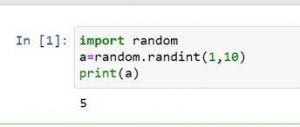
A random number generator Python is a tool that generates numbers that appear to be random. While the generated numbers are not truly random (they are determined by a deterministic algorithm), they exhibit properties of randomness and are suitable for most applications.
Python provides a vast array of modules and functions that facilitate the generation and utilization of random data. This guide aims to help you incorporate these functions into your code by offering code snippets for your convenience.
What is the algorithm used for random number generation?
The algorithm used for random number generator Python depends on the version of Python you are using.
In Python 3, the default random number generator is based on the Mersenne Twister algorithm, which is a highly regarded pseudorandom number generator (PRNG). The Mersenne Twister algorithm is designed to have a long period, meaning it can generate a large number of unique random values before repeating. It is known for its good statistical properties and is widely used in various programming languages.
Python’srandom module provides functions for generating random numbers using the Mersenne Twister algorithm. Some of the commonly used functions in the random module include random(), which generates a random float between 0 and 1, randint(a, b), which generates a random integer between a and b, and choice(seq), which selects a random element from a sequence.
It’s worth noting that while the Mersenne Twister algorithm is suitable for most general-purpose applications, it is not suitable for cryptographic or security-sensitive purposes. For those use cases, the secrets module in Python provides functions for generating cryptographically strong random numbers using system-specific sources of randomness.
If you need more control over the random number generation process, Python also provides the random.Random class, which allows you to create separate instances of random number generators with their own internal state.
Overall, the Mersenne Twister algorithm is the default algorithm for random number generation in Python, but it’s important to choose the appropriate functions and modules based on your specific requirements, whether it’s for general-purpose randomness or cryptographic security.
How to make a random number generator Python

Python provides the random module for random number generation. This module offers functions such asrandom(), which generates random floating-point numbers between 0 and 1, andrandint(a, b), which generates random integers between a and b. Additionally, the module includes functions for shuffling elements, selecting random elements from a sequence, and more.
Random number generation has various applications, including simulations, games, cryptography, and statistical analysis. Simulations can use random numbers to model uncertain events and generate realistic data. Games often rely on random numbers for unpredictable outcomes. Cryptography utilizes random numbers for key generation and secure communication. Statistical analysis employs random numbers for sampling and generating random variables.
In Python, you can create a random number generator python by using the random module. Here’s an example of how to generate random numbers in Python:
import random
# Generate a random float between 0 and 1
random_float = random.random()
print(random_float)
# Generate a random integer between a and b (inclusive)
a = 1
b = 10
random_integer = random.randint(a, b)
print(random_integer)
# Generate a random element from a sequence
my_list = [1, 2, 3, 4, 5]
random_element = random.choice(my_list)
print(random_element)
In the above random number generator Python example, therandom() function generates a random float between 0 and 1. The randint(a, b) function generates a random integer between a and b inclusive. The choice(seq) function selects a random element from the given sequence (my_list in this case).
You can also set the random seed using the seed() function if you want to generate the same sequence of random numbers repeatedly. For example:
import random
# Set the random seed
random.seed(10)
# Generate random numbers
random_number1 = random.random()
random_number2 = random.random()
print(random_number1)
print(random_number2)
By setting the seed to the same value, you will get the same sequence of random numbers each time you run the code.
Remember to import the random module at the beginning of your Python script to use these random number generation functions.
How to make a random number generator Python NumPy

If you want to use the NumPy library in Python to generate random numbers, you can utilize the numpy.random module. NumPy provides a wide range of random number generation functions with additional features and capabilities. Here’s an example of how to use NumPy for random number generation:
import numpy as np
# Generate a random float between 0 and 1
random_float = np.random.random()
print(random_float)
# Generate an array of random floats between 0 and 1
random_array = np.random.random(size=(3, 3))
print(random_array)
# Generate a random integer between a and b (exclusive)
a = 1
b = 10
random_integer = np.random.randint(a, b)
print(random_integer)
# Generate an array of random integers between a and b (exclusive)
random_int_array = np.random.randint(a, b, size=(3, 3))
print(random_int_array)
# Generate a random element from a sequence
my_list = [1, 2, 3, 4, 5]
random_element = np.random.choice(my_list)
print(random_element)
In the above example, np.random.random() generates a random float between 0 and 1, and np.random.random(size=(3, 3)) generates an array of random floats of size 3×3. np.random.randint(a, b) generates a random integer between a and b (exclusive), and np.random.randint(a, b, size=(3, 3)) generates an array of random integers of size 3×3. Finally, np.random.choice(my_list) select a random element from the given sequence (my_list in this case).
NumPy’s random number generation functions offer additional functionalities, such as generating numbers from specific probability distributions or sampling with replacement. You can refer to the NumPy documentation for more details on the available functions and their usage.
Pseudo random number generator Python
In Python, you can use the built-in random module to generate pseudo-random numbers. The random numbers generated by this module are not truly random but are determined by a deterministic algorithm. Here’s an example of how to use the random module for pseudo-random number generation:
import random
# Generate a random float between 0 and 1
random_float = random.random()
print(random_float)
# Generate a random integer between a and b (inclusive)
a = 1
b = 10
random_integer = random.randint(a, b)
print(random_integer)
# Shuffle a list randomly
my_list = [1, 2, 3, 4, 5]
random.shuffle(my_list)
print(my_list)
# Select a random element from a sequence
random_element = random.choice(my_list)
print(random_element)
In the above random number generator Python example, random.random() generates a random float between 0 and 1. random.randint(a, b) generates a random integer between a and b, inclusive. random.shuffle(my_list) shuffles the elements of the list randomly, and random.choice(my_list) selects a random element from the given sequence (my_list in this case).
Note that the pseudo-random number generator in the random module is based on the Mersenne Twister algorithm, as discussed earlier. If you need more control over the random number generation process or require cryptographically secure random numbers, you can explore other libraries like numpy or secrets Python.
Random number generator Python code
A random number generator in Python is a program or code that generates random numbers. Python provides several modules for random number generation, with the most commonly used one being the random module. Here’s an example code snippet that demonstrates the usage of random number generation in Python:
import random
# Generate a random integer between 1 and 10
random_number = random.randint(1, 10)
print("Random number:", random_number)
# Generate a random float between 0 and 1
random_float = random.random()
print("Random float:", random_float)
# Generate a random element from a sequence
my_list = ["apple", "banana", "cherry", "date"]
random_element = random.choice(my_list)
print("Random element:", random_element)
In this code, we import the random module and use different functions:
Random number generator Python code examples:

Here’s an example of a random number generator code in Python using the random module:
import random
# Generate a random float between 0 and 1
random_float = random.random()
print(random_float)
# Generate a random integer between a and b (inclusive)
a = 1
b = 10
random_integer = random.randint(a, b)
print(random_integer)
# Generate a random element from a sequence
my_list = [1, 2, 3, 4, 5]
random_element = random.choice(my_list)
print(random_element)
In this random number generator Python code, we import the random module and use various functions to generate random numbers.
random.random()generates a random float between 0 and 1.random.randint(a, b)generates a random integer betweenaandb, inclusive.random.choice(my_list)selects a random element from the given sequence (my_listin this case).
You can modify the code based on your specific requirements or use additional functions provided by the random module for more advanced random number generation.



